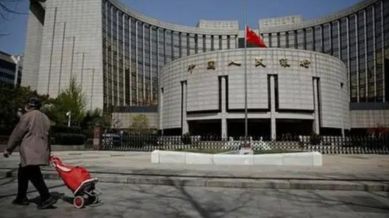China’s stimulus bazooka likely to weigh in on battered Indian markets
If the third quarter numbers and leading indicators reflect recovery in earnings, the scenario can change with FPIs reducing selling and even turning buyers.

The ‘Sell India, buy China’ strategy of global investors is likely to retain momentum with China on Friday approving a $1.4 trillion plan to revive the economy that authorises local governments to sort out the debt problems. The China gambit could see further potential outflow of capital from the battered domestic markets which saw a record-high net outflow of over Rs 1.30 lakh crore since October this year in response to the rise in Chinese equities following the announcement of aggressive fiscal stimulus measures.
While China’s Finance Minister Lan Foan said more stimulus was coming, analysts say that Beijing may not want to exhaust all its weapons in its arsenal before Trump takes over officially in January. The Chinese stimulus package has come a day after the US Federal Reserve and the Bank of England cut the interest rates by 25 basis points and a series of cuts by the People’s Bank of China in the recent months to revive the economy.
monthly limit of free stories.
with an Express account.
While the latest Chinese stimulus was somewhat below expectations by global markets, the measures will continue to impact the domestic market which has been hit by a sell-off triggered by foreign portfolio investors (FPIs). As a result, the BSE Sensex has plunged 7.55 per cent to 79,486.32 since September 29, 2024 when the Sensex hit a peak of 85,978.25.
Global markets consider the latest Chinese measures not as a stimulus package. It’s basically a debt swap to shore up local government’s finances which may not boost consumption, and instead they are designed to stop a financial crisis domestically in China. Even that will attract more foreign inflows at the cost of emerging markets like India.
The recent efforts by the People’s Bank of China (PBOC) to revive the China economy, including measures like reduced reserve requirements for banks, lower down payments for home purchases, and tax incentives for new home buyers have had a cascading effect on emerging markets, mainly India. China’s equity markets have shown flat annualized returns of 1.22 per cent over the past 15 years, compared to India’s impressive 11.2 per cent, according to a report by Client Associates (CA).
“The appealing valuations of other Asian peers and ongoing stimulus measures by China are also contributing to the underperformance of the national market. China has now announced a new debt refinancing plan with a raising of the debt ceiling by 6 trillion yuan from 29.52 trillion yuan aimed at easing the local government’s fiscal pressures,” said Vinod Nair, Head of Research, Geojit Financial Services. If investors see the possibility of Chinese economy revving up, its inflows could rise dramatically. This means less allocation and more sell-offs in countries like India.
The rationale for the FPI selling is the elevated valuations in India and preference for China which appear conspicuous in the context of the earnings deceleration evident in the second quarter financial numbers. If the third quarter numbers and leading indicators reflect recovery in earnings, the scenario can change with FPIs reducing selling and even turning buyers. Investors will have to wait and watch for the data. While the recent rebound in India’s domestic manufacturing activity is a positive sign, this year government spending is expected to be back ended due to general elections this year, so there is a leading expectation of improved corporate earnings in the second half of FY25. The festive season in the third quarter is likely to revive consumption, which should support market sentiment and will aid find a floor in the near future.
On the global front, the conclusion of the US elections and a strong Republican majority have reduced political uncertainty, providing relief to global markets. The US Fed’s recent 25 bps interest rate cut, which was in line with expectations, also offers some support. Key economic data points like the Index of Industrial Production (IIP) and inflation will be keenly watched. “Consensus expects an increase in inflation in the short-term and an expansion in IIP. The market will continue to be influenced by Q2 earnings, Trump policies and actions by FIIs. The US market is expected to outperform the rest of the market in the short to medium-term,” said an analyst with a broking firm.
What has thrown the spanner in the works of the RBI and the market is the high retail inflation.
On November 6, Reserve Bank of India Governor Shaktikanta Das said the consumer price-based index (CPI) which accelerated to 5.5 per cent in September, is likely to escalate further in October. The Governor stated that the change in monetary policy stance in the October policy to ‘neutral’ from ‘withdrawal of accommodation’ should not be interpreted as a cut in the repo rate in the next policy, dampening hopes of the much-awaited reduction in the key policy rate.